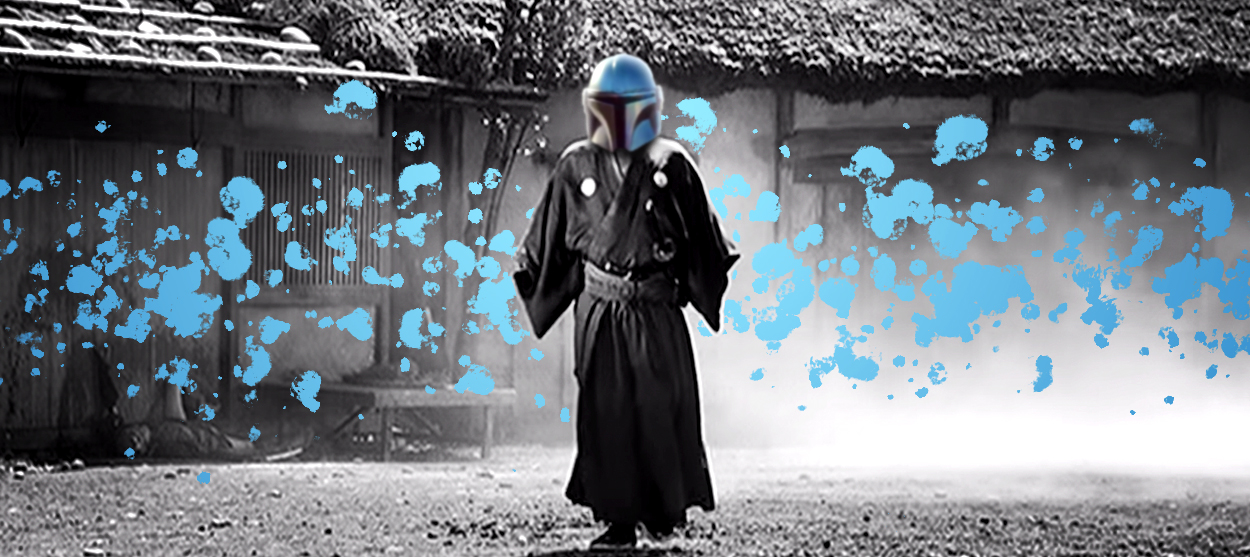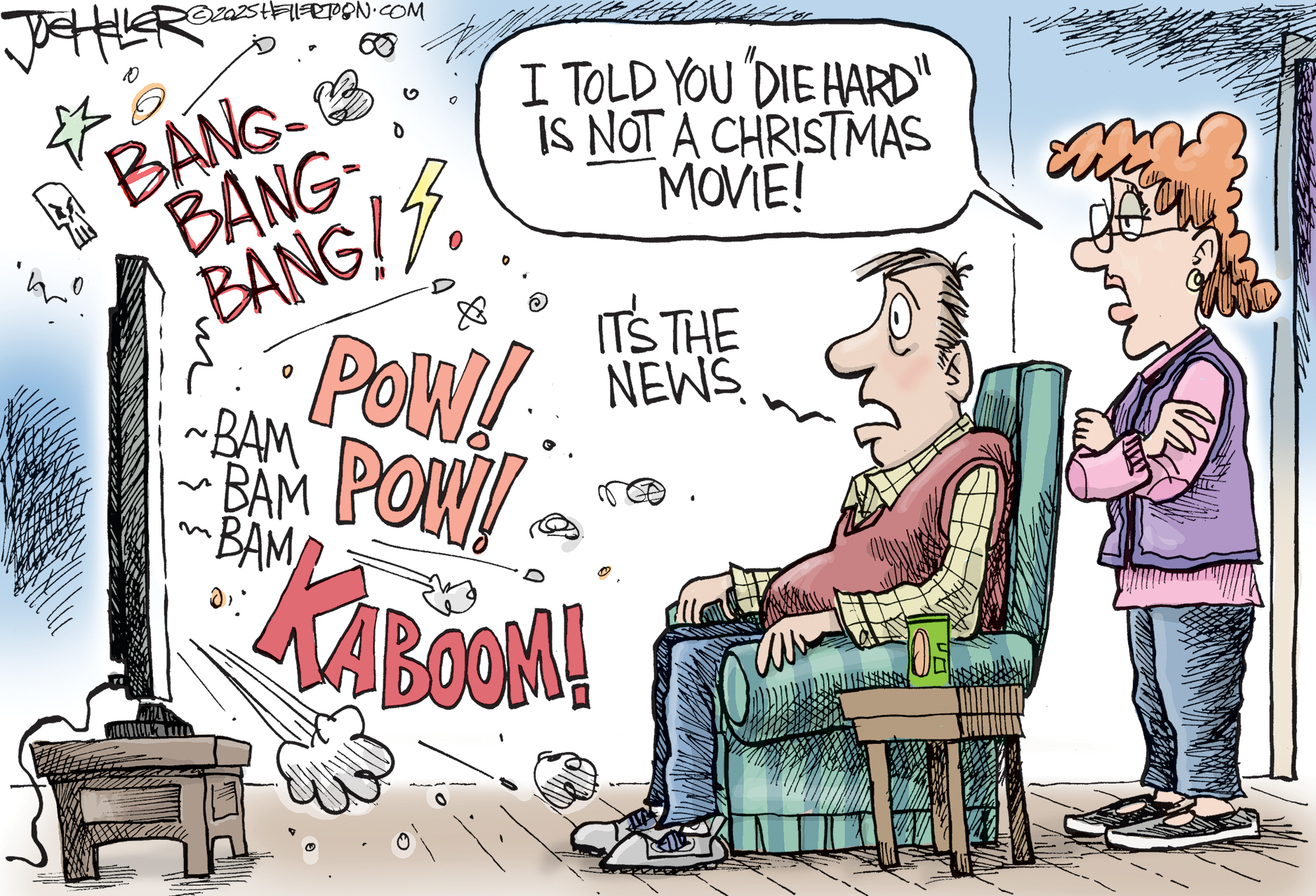Does a 1961 Samurai film give away the plot of The Mandalorian?
We don't know much about the forthcoming Disney+ series. Or do we?


What we know for sure about The Mandalorian: It's about a bounty hunter from the planet Mandalore. It takes place after the end of Star Wars: Episode VI – Return of the Jedi and before the beginning of Star Wars: Episode VII – The Force Awakens. It's set somewhere on the lawless galactic frontier, far from the reach of the New Republic.
Beyond those meager details, though, we don't know ... well, anything. We don't, for example, know the Mandalorian's name, who he's hunting, or what the heck Werner Herzog is doing in the show. Most aggravating of all, with less than 24 hours left before the show debuts, we really don't even have the slightest idea what The Mandalorian is about.
Or ... do we? Actor Pedro Pascal, who plays the series' title character, let slip during an interview at Disney's D23 Expo that The Mandalorian is "very, very much narratively" inspired by Akira Kurosawa's 1961 Samurai film, Yojimbo.
The Week
Escape your echo chamber. Get the facts behind the news, plus analysis from multiple perspectives.

Sign up for The Week's Free Newsletters
From our morning news briefing to a weekly Good News Newsletter, get the best of The Week delivered directly to your inbox.
From our morning news briefing to a weekly Good News Newsletter, get the best of The Week delivered directly to your inbox.
Admittedly, Pascal didn't name Yojimbo specifically during the interview. What he did say, though, is that his performance of the Mandalorian character is "built on the iconic presence of the Man With No Name in the Sergio Leone movies, played by Clint Eastwood, [and] the lone samurai [Toshiro Mifune] in Akira Kurosawa. It's aesthetically and very, very much narratively built in that kind of iconic lone gunslinger/sword-wielder." Eastwood's Man With No Name character notably debuted in the 1964 Spaghetti Western A Fistful of Dollars, which was so blatantly modeled on Kurosawa's Yojimbo that the Japanese production company, Toho, actually attempted to sue. What all this means for Star Wars fans today is that if The Mandalorain is indeed "very, very much narratively" inspired by that Samurai story, then we actually have a much better idea of its plot than it initially seemed.
Really, it ought to be no surprise that the answer to fans' most burning questions could potentially be found in Kurosawa's films. Star Wars' creator, George Lucas, is a professed superfan of the Japanese director's movies, with Luke Skywalker's story inspired by the 1958 film The Hidden Fortress. A number of Star Wars movies over the years have lifted directly from Kurosawa's films in other ways, including Lucas' use of soft wipes to transition between scenes. More relevant might be the composition of a sequence of shots in Episode IV, when Ben cuts off the arm of a scoundrel during a brawl in the Mos Eisley Cantina. The shot, which includes a dramatic cut to a disembodied limb still clutching its weapon, is identical to a shot that originated in Yojimbo.
Fans of The Mandalorian ought to pay particular attention to the title of Yojimbo, which translates to "bodyguard." As is the case in A Fistful of Dollars too, Yojimbo follows the story of an unnamed strangers' arrival in a town plagued by violence between two dueling crime bosses. This stranger, a talented fighter, decides to play the syndicates against each other, offering his services as a protector to both sides. His scheme unravels when he decides to save a family caught up in the violence; by freeing them, he is discovered to be a double-crosser. Caught and beaten, the stranger eventually manages to escape while setting in motion a final battle between the crime bosses, who destroy each other. Peace returns to the town, and the stranger, satisfied, moves on.
The Mandalorian, a seemingly self-interested bounty hunter from a planet renowned for its warriors, is quite obviously modeled on Kurosawa's bodyguard. To make the relation even more obvious, one of the trailers has actress Ming-Na Wen's character tell him, "your name will be legendary," a statement that is both ironic (since viewers still don't — and might never? — know his name) and also a nod to Eastwood's Man with No Name. With this being the established inspiration, one has to wonder if the show will take the natural next step and have Pascal's character also become some kind of double-crosser between two groups of thugs, with his Achilles heel being that inconvenient heart of gold.
A free daily email with the biggest news stories of the day – and the best features from TheWeek.com
Disney's summary gives no indication either way, reading vaguely that "a Mandalorian bounty hunter tracks a target for a well-paying client," "target in-hand, the Mandalorian must now contend with scavengers," and "the battered Mandalorian returns to his client for reward" — all of which leaves open the possibility that, in the employ of one mysterious group, he may eventually hawk his services to another. Since the show takes place after the fall of the Empire but before the rise of the First Order (that being the group that Kylo Ren will be a part of in The Force Awakens), it seems likely that the Mandalorian could easily encounter dubious characters who take advantage of the frontier's lawlessness as well as Imperial sympathizers who might have fled after the victory of the Rebel Alliance. Might these be The Mandalorian's versions of Yojimbo's crime lords?
All indications seem to suggest so. The original Star Wars movies were fixated on a universe made of blacks and whites: There is a literal Dark Side and a Light Side, and the tension in the first two trilogies hinged on the question of what would drive someone from one to the other. Yojimbo and A Fistful of Dollars are much more interested in the gray area, and the characters who operate between the binaries. The stranger is both self-interested, stoking violence for his own profit, but also selfless, getting caught due to his decision to protect a vulnerable family. The character of the Mandalorian, being a bounty hunter, seems destined to struggle between the poles of good and evil too, just like Kurosawa's protagonist.
Why would Disney borrow the plot of a decades-old story after all these years, though? Well, most convincingly, because it's a good one; stealing from Yojimbo paid off for Leone and Eastwood, anyway. More significantly, modern Star Wars projects have continued to pay homage to George Lucas' original vision, one that itself owed a great debt to Kurosawa. Nothing would be more fitting than to continue to honor The Mandalorian's roots than with a nod, however big or small, to the bodyguard.
Want more essential commentary and analysis like this delivered straight to your inbox? Sign up for The Week's "Today's best articles" newsletter here.
Jeva Lange was the executive editor at TheWeek.com. She formerly served as The Week's deputy editor and culture critic. She is also a contributor to Screen Slate, and her writing has appeared in The New York Daily News, The Awl, Vice, and Gothamist, among other publications. Jeva lives in New York City. Follow her on Twitter.
-
 Political cartoons for December 21
Political cartoons for December 21Cartoons Sunday’s political cartoons include Christmas movies, AI sermons, and more
-
 A luxury walking tour in Western Australia
A luxury walking tour in Western AustraliaThe Week Recommends Walk through an ‘ancient forest’ and listen to the ‘gentle hushing’ of the upper canopy
-
 What Nick Fuentes and the Groypers want
What Nick Fuentes and the Groypers wantThe Explainer White supremacism has a new face in the US: a clean-cut 27-year-old with a vast social media following
